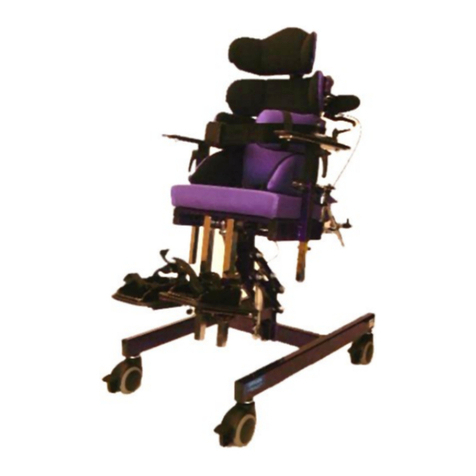Throughout the manual there are important points to note identified by the symbol: !
Ensure all adjustment mechanisms are secure and in place before operation. If it is
likely that the hand-wheels will be repeatedly loosened, JCM can supply allen key bolts
as an alternative. We strongly recommend this if there is a danger from those in the
vicinity of the user.
All postural support straps and harnesses should be in place and properly adjusted to
the user, prior to usage of any kind (see pages 8 & 9).
Whilst the seating system is stable on a 5-degree slope, even in its most upright position,
it is not intended to be used in this manner. It is however, intended to be used on a level
flat floor, where movement is confined to a single room. For safety ALWAYS return the
product to a neutral position before moving (lower in height, level the seat, ensure the
back is upright etc).
Heavy items on the tray will affect stability. The fitting of anything other than the standard
JCM tray may substantially affect the stability of the seating system and should therefore
be checked before issue.
If at any time it is noted that areas of the users skin remain reddened after being out of the
seating system for around 10 minutes, urgently contact the qualified professional who
performed the hand over of the equipment. This may be a sign of excessive pressure
being exerted by the seating. This might occur in the initial use of a new seat where
further adjustment may be required, where the user has been badly placed, grown or
where an underlying medical problem exists. Review may be necessary in such cases
After completing any alterations ENSURE all nuts, bolts, knobs, hand wheels and other
fixings are securely tightened and in position, and that they are regularly checked as
part of the maintenance of the chair. Never over adjust or over tighten moving parts.
Keep all products away from excessive sources of heat, cigarettes and naked flames.
If you suspect that the system may be faulty, cease use of the equipment straight away
and immediately contact the organization who supplied the system. (JCMs contact
information can be found on the back cover).
The equipment will be labelled with important information. NEVER REMOVE these
information labels or allow them to be defaced, overlaid or altered.
All modifications, adjustments, reconditioning, repairs, disposal, and servicing of the
seating unit must ONLY be carried out by the agencies who supplied the equipment
(see pages 20-21).
•
•
•
•
•
•
•
•
•
•
Important Safety Advice !
We at JCM are committed to producing products of the highest standard. All of our
products fulfil the essential safety and environmental requirements as defined in
the European Directives. However, improper use of the products will potentially put
the users at risk and therefore JCM strongly suggest that the following information
is strictly adhered to at all times.




























